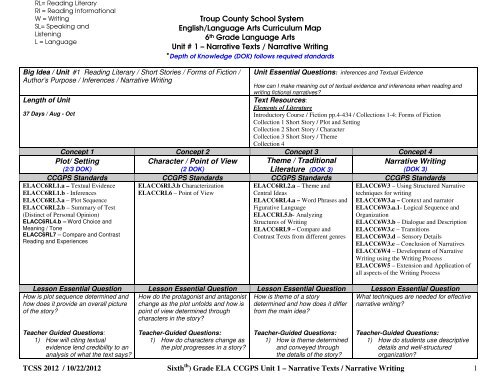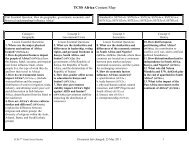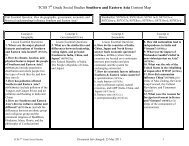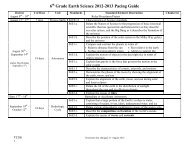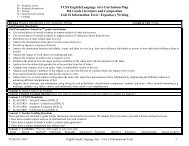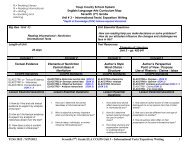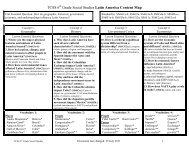TCSS 2012 / 10/22/2012 Sixth ) Grade ELA CCGPS Unit 1 ...
TCSS 2012 / 10/22/2012 Sixth ) Grade ELA CCGPS Unit 1 ...
TCSS 2012 / 10/22/2012 Sixth ) Grade ELA CCGPS Unit 1 ...
You also want an ePaper? Increase the reach of your titles
YUMPU automatically turns print PDFs into web optimized ePapers that Google loves.
RL= Reading Literary<br />
RI = Reading Informational<br />
W = Writing<br />
SL= Speaking and<br />
Listening<br />
L = Language<br />
Big Idea / <strong>Unit</strong> #1 Reading Literary / Short Stories / Forms of Fiction /<br />
Author’s Purpose / Inferences / Narrative Writing<br />
Length of <strong>Unit</strong><br />
37 Days / Aug - Oct<br />
<strong>ELA</strong>CC6RL1.a – Textual Evidence<br />
<strong>ELA</strong>CC6RL1.b - Inferences<br />
<strong>ELA</strong>CC6RL3.a – Plot Sequence<br />
<strong>ELA</strong>CC6RL2.b – Summary of Test<br />
(Distinct of Personal Opinion)<br />
<strong>ELA</strong>CC6RL4.b – Word Choice and<br />
Meaning / Tone<br />
<strong>ELA</strong>CC6RL7 – Compare and Contrast<br />
Reading and Experiences<br />
Troup County School System<br />
English/Language Arts Curriculum Map<br />
6 th <strong>Grade</strong> Language Arts<br />
<strong>Unit</strong> # 1 – Narrative Texts / Narrative Writing<br />
*Depth of Knowledge (DOK) follows required standards<br />
<strong>Unit</strong> Essential Questions: inferences and Textual Evidence<br />
How can I make meaning out of textual evidence and inferences when reading and<br />
writing fictional narratives?<br />
Text Resources:<br />
Elements of Literature<br />
Introductory Course / Fiction pp.4-434 / Collections 1-4: Forms of Fiction<br />
Collection 1 Short Story / Plot and Setting<br />
Collection 2 Short Story / Character<br />
Collection 3 Short Story / Theme<br />
Collection 4<br />
Concept 1 Concept 2 Concept 3 Concept 4<br />
Plot/ Setting<br />
Character / Point of View Theme / Traditional<br />
Narrative Writing<br />
(2/3 DOK)<br />
(2 DOK)<br />
Literature (DOK 3)<br />
(DOK 3)<br />
<strong>CCGPS</strong> Standards <strong>CCGPS</strong> Standards <strong>CCGPS</strong> Standards <strong>CCGPS</strong> Standards<br />
<strong>ELA</strong>CC6RL3.b Characterization <strong>ELA</strong>CC6RL2.a – Theme and <strong>ELA</strong>CC6W3 – Using Structured Narrative<br />
<strong>ELA</strong>CCRL6 – Point of View<br />
Central Ideas<br />
techniques for writing<br />
<strong>ELA</strong>CC6RL4.a – Word Phrases and <strong>ELA</strong>CC6W3.a – Context and narrator<br />
Figurative Language<br />
<strong>ELA</strong>CC6W3.a.1- Logical Sequence and<br />
<strong>ELA</strong>CCRL5.b- Analyzing<br />
Organization<br />
Structures of Writing<br />
<strong>ELA</strong>CC6W3.b – Dialogue and Description<br />
<strong>ELA</strong>CC6RL9 – Compare and <strong>ELA</strong>CC6W3.c – Transitions<br />
Contrast Texts from different genres <strong>ELA</strong>CC6W3.d – Sensory Details<br />
<strong>ELA</strong>CC6W3.e – Conclusion of Narratives<br />
<strong>ELA</strong>CC6W4 – Development of Narrative<br />
Writing using the Writing Process<br />
<strong>ELA</strong>CC6W5 – Extension and Application of<br />
all aspects of the Writing Process<br />
Lesson Essential Question Lesson Essential Question Lesson Essential Question Lesson Essential Question<br />
How is plot sequence determined and<br />
how does it provide an overall picture<br />
of the story?<br />
Teacher Guided Questions:<br />
1) How will citing textual<br />
evidence lend credibility to an<br />
analysis of what the text says?<br />
How do the protagonist and antagonist<br />
change as the plot unfolds and how is<br />
point of view determined through<br />
characters in the story?<br />
Teacher-Guided Questions:<br />
1) How do characters change as<br />
the plot progresses in a story?<br />
How is theme of a story<br />
determined and how does it differ<br />
from the main idea?<br />
Teacher-Guided Questions:<br />
1) How is theme determined<br />
and conveyed through<br />
the details of the story?<br />
What techniques are needed for effective<br />
narrative writing?<br />
Teacher-Guided Questions:<br />
1) How do students use descriptive<br />
details and well-structured<br />
organization?<br />
<strong>TCSS</strong> <strong>2012</strong> / <strong>10</strong>/<strong>22</strong>/<strong>2012</strong> <strong>Sixth</strong> th ) <strong>Grade</strong> <strong>ELA</strong> <strong>CCGPS</strong> <strong>Unit</strong> 1 – Narrative Texts / Narrative Writing 1
2) How do I find textual evidence<br />
to support my analysis?<br />
3) How will citing textual<br />
evidence lend credibility to my<br />
analysis of inferences drawn<br />
from the text?<br />
4) How do I determine inferences<br />
drawn from the text?<br />
5) How do inferences affect the<br />
meaning of the text?<br />
6) What is plot sequence?<br />
7) How does plot sequence<br />
provide a picture of the story?<br />
8) Why is accurate summary<br />
(distinct from personal<br />
opinion) important?<br />
9) How does an author’s choice<br />
of words affect his meaning?<br />
2) How does an author use the<br />
protagonist vs. antagonist to<br />
advance the plot?<br />
3) What is first person point of<br />
view?<br />
4) What is third person point of<br />
view?<br />
5) How is point of view<br />
determined and how is it<br />
developed by the author?<br />
2) What is the difference<br />
between implied and<br />
stated themes and how<br />
are each determined?<br />
3) Why is it important to<br />
provide an accurate<br />
summary o the text?<br />
4) How does the reader use<br />
contextual evidence to<br />
determine meaning of<br />
words and phrases?<br />
5) How does the reader use<br />
sensory details sensory<br />
details and figurative<br />
language to determine<br />
meaning of words and<br />
phrases?<br />
6) How does an author’s<br />
choice of words affect his<br />
meaning?<br />
2) How do students of writing<br />
engage their reader or introduce a<br />
narrator or characters in a story?<br />
3) How do students of narrative<br />
writing use dialogue, pacing, and<br />
description effectively?<br />
4) How do students of writing learn<br />
to make transitions effectively?<br />
5) What are the most commonly<br />
used transitional words that will<br />
advance plot?<br />
<strong>10</strong>) How does word choice affect<br />
the tone of the passage?<br />
Vocabulary Vocabulary Vocabulary Vocabulary<br />
• Plot Sequence<br />
• Conflict – External / Internal<br />
• Episodes<br />
• Details<br />
• Organization<br />
• Pacing<br />
• Plot diagram – Exposition, Rising<br />
Action, Climax, Falling Action,<br />
Resolution / Conclusion<br />
• Personal Opinion<br />
• Tone Words – Ex: angry, excited,<br />
scared, happy, jovial, etc.<br />
• Characterization<br />
• Character Motivation<br />
• Antagonist vs. Protagonist<br />
• 1<br />
• Mood<br />
• Dialogue<br />
• Flashback<br />
• Foreshadowing<br />
• Fluency<br />
• Reading Aloud<br />
• Video<br />
st Person POV<br />
3 rd Person Limited<br />
• 3 rd • Main Idea<br />
• Engaging the reader<br />
Person Omniscient<br />
• Universal Theme<br />
• Implied Theme<br />
• Stated Theme<br />
• Historical Novels<br />
• Short Stories<br />
• Cultural Literature<br />
• Myths<br />
• Legend<br />
• Fables<br />
• Transition words<br />
• Structural Organization(Chronological)<br />
• Vivid Details – Vivid Verbs, Descriptive<br />
Adjectives<br />
• Context<br />
• Brainstorming / Pre-Writing<br />
• Drafting<br />
• Revision<br />
• Editing/ Peer Editing<br />
• Tricksters<br />
Publishing<br />
• Fairy Tale<br />
• Fantasy Stories<br />
• Denotation (Contextual)<br />
• Oral Tradition<br />
• Story Telling<br />
• Narrative technique<br />
• Narrative Style<br />
• Writing Style (Student work)<br />
• Concluding Paragraph<br />
• Ideas<br />
<strong>TCSS</strong> <strong>2012</strong> / <strong>10</strong>/<strong>22</strong>/<strong>2012</strong> <strong>Sixth</strong> th ) <strong>Grade</strong> <strong>ELA</strong> <strong>CCGPS</strong> <strong>Unit</strong> 1 – Narrative Texts / Narrative Writing 2
• Sensory Language<br />
• Connotative Meaning<br />
• Loaded Words<br />
Performance Tasks Performance Tasks Performance Tasks Performance Tasks<br />
“La Bamba”<br />
“The Gold Cadillac”<br />
“All Summer in a Day”<br />
“The Bracelet”<br />
Writing to Win – application of knowledge<br />
for narrative writing<br />
Novel of your choice (as available in the<br />
Media Centers)<br />
“La Bamba”<br />
“The Gold Cadillac”<br />
“All Summer in a Day”<br />
“The Bracelet”<br />
Writing to Win – application of knowledge<br />
for narrative writing<br />
Novel of your choice (as available in the<br />
Media Center<br />
“La Bamba”<br />
“The Gold Cadillac”<br />
“All Summer in a Day”<br />
“The Bracelet”<br />
Writing to Win – application of<br />
knowledge for narrative writing<br />
Novel of your choice (as available in<br />
the Media Centers)<br />
• County All-Write<br />
• Writing to Win – Narrative Experiences<br />
• Writing Process Activities<br />
Resources – Concept 1 Resources – Concept 2 Resources – Concept 3 Resources – Concept 4<br />
Collection 1<br />
Collection 2<br />
Elements of Literature - Resources<br />
Forms of Fiction – Collection 1<br />
Short Story / Theme – Collection 4<br />
Introductory Course / “Short Story Theme”<br />
pp. 344- 434; ;” Re-teaching Lessons:<br />
Theme 859J ; Theme /Subject 371; Theme<br />
/ Plot 385<br />
Elements of Literature – Introductory<br />
Course /Fiction pp.4-434; Drama pp.742-<br />
746; “Media Workshop p. 842; Re-teaching<br />
Plot p. 859 e & f; Plot / Conflict 141;<br />
Plot/Setting 153; Theme / Plot 385<br />
Collection 1<br />
Collection 3<br />
Elements of Literature –Introductory<br />
Course / Fiction pp.4-434; “Re-teaching<br />
Lessons: Speakers and Narration” – p.<br />
859J; Autobiography and First Person 471;<br />
First and Third Person 479; Biography<br />
and Third Person 493;<br />
Elements of Literature<br />
Teacher Resources – Collection 1<br />
“Forms of Fiction / Point of View”<br />
Elements of Literature – Fiction – “Short<br />
Story Character” – pp. 232-236; “What<br />
Reading Skills Help You Understand<br />
Character” – p. 236; “Literary Skills<br />
Review” – p. 334;”Reteaching Character” –<br />
p. 859; Characterization 245, 255;<br />
Character and Conflict 271, 281<br />
Collection 1<br />
Collection 4<br />
Elements of Literature - Audio CD’s<br />
(Holt –Teacher Resources;<br />
Visualizing Poetry (suggested<br />
comparisons for metaphor) John<br />
Henry, The Toaster, Steam Shovel,<br />
Sidewalk Racer, Things to do if you<br />
were a Sidewalk 713-717; “Analyzing<br />
Visuals” 578;<br />
Novels to Consider -<br />
The Secret Garden; Tuck Everlasting<br />
(Compare/Contrast video to text)<br />
DVD’s of stories, poems, or<br />
dramas / Approved and Viewed<br />
Located in the Media Center and<br />
Teacher Resources / Extensive<br />
selections are available<br />
(Teachers are reminded to use<br />
previously viewed videos that<br />
correspond with the text)<br />
Elements of Literature<br />
“The Storytelling Stone” p. <strong>10</strong> – “He<br />
Lion, Bruh Bear, and Bruh Rabbit -<br />
Folk Tale “The Fox and the Crow /<br />
The Wolf and House Dog”<br />
Fables 54 “Do or Die from Gilgamesh<br />
the Hero” Myth / Epic 60<br />
Elements of Literature<br />
Suspense / Foreshadowing 789; “Reteaching<br />
Lessons: Plot 859.F; Theme<br />
p. 859J<br />
Elements of Language<br />
Chapter 1 – Grammar, Usage, and Mechanics<br />
pp. 46-390; Chapter 2 – Sentences and<br />
Paragraphs – 426-444<br />
Language Handbook Worksheets<br />
• pp. 83-<strong>10</strong>0<br />
Elements of Language – pp. 444-455 –<br />
“What is a Paragraph?” – “What Makes a<br />
Good Paragraph?” Organizing Ideas, Spatial<br />
Order; Chronological Order etc<br />
.Chapter 18 – “Sharing Our Stories”<br />
6 + 1 Writing Traits – Ideas, Organization,<br />
Style<br />
.<br />
<strong>TCSS</strong> <strong>2012</strong> / <strong>10</strong>/<strong>22</strong>/<strong>2012</strong> <strong>Sixth</strong> th ) <strong>Grade</strong> <strong>ELA</strong> <strong>CCGPS</strong> <strong>Unit</strong> 1 – Narrative Texts / Narrative Writing 3


